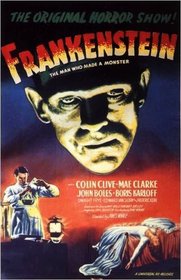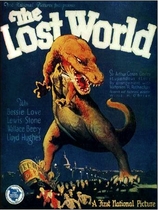Our editor-in-chief Nate Yapp is proud to have contributed to the new book Hidden Horror: A Celebration of 101 Underrated and Overlooked Fright Flicks, edited by Aaron Christensen. Another contributors include Anthony Timpone, B.J. Colangelo, Dave Alexander, Classic-Horror.com's own Robert C. Ring and John W. Bowen. Pick up a copy today from Amazon.com!
Frankenstein (1931)
Few images from the last century are so universal as to be a part of the social unconscious. A flat-top head, a pair of bolts in the neck, and a skin tone ranging from gray to green - show that to anybody, and they'll say "Frankenstein." A little research will show that such a description didn't come from Mary Shelley's novel. Frankenstein (or, more accurately, Frankenstein's Monster) may have started out as a character in a book, but it was in James Whale's 1931 classic (and very loose) adaptation that he achieved cultural godhood - and it's not hard to see why.
After an oft-imitated introduction where the audience is warned of the horrific nature of the film, we open on a graveyard, more specifically a funeral. A grave is surrounded by crying mourners (who, by the way, are very important to the impact of the scene). Off to the corner, out of the view of the bereaved, is one Henry Frankenstein (Colin Clive) and his hunchback assistant Fritz (Dwight Frye). Fritz is a little too interested, and must be admonished by his employer. They watch one man fill the grave, with full knowledge that they will undo and then redo his work before the night is out.
Thus begins a tale of obsession, madness, and perverted science that can only end in tears and tragedy. The later plot is nearly too well-known to repeat. On a stormy night, the scientist and his assistant bring to life an inhuman being, stitched together from the parts of corpses, infused with the spark of electricity (thanks to Ken Strickfaden's wildly Expressionistic apparatus).
Most of the players of Universal's early-to-mid 1930s are here: Frye, Edward Van Sloan as Frankenstein's mentor, makeup artist Jack Pierce, special effects whiz John Fulton, writers Garrett Fort and John L. Balderston, and director James Whale. Playing the monster was a then-unknown British extra, born William Henry Pratt, credited as "???", but better known to the world at large as Boris Karloff.
It is Karloff that remains in the mind long after the VCR has snapped off. It is Karloff who provides the enduring image of Frankenstein's monster, an interpretation which has been imitated, misinterpreted, and parodied more times than one can count. He adds a depth to what could have simply been a lumbering hulk (and probably would have been in the hands of a different actor). The pathos he inspires in his introductory moments is nearly Shakespearean - and all without a word.
The "abnormal brain" subplot becomes almost unnecessary in Karloff's hands. His monster is little more than a child who's given too much power and not enough love from his "father". Revivifying any dead brain might have done that (but then my Frankenstein 12-inch doll wouldn't have that cute little plastic brain in a jar).
Most of the rest of the cast is nearly as admirable. Clive masters insane histrionics, much to the benefit of the film. His screaming of "It's ALIVE" is one of the highlights of film history (it's just a shame about the rest of the line - see the Trivia). Van Sloan adds his vaguely European accent and confidence to the part (is it just me, or does he always seem like he knows everything? He's like Mr. Wizard!). John Boles is the unnecessary secondary romantic lead that tends to get thrust in these movies for reasons beyond my conception. He's a minor annoyance (and he thankfully disappears in the sequel, Bride of Frankenstein).
As for Elizabeth, Mae Clark is acceptable in the role, but she tends to fall back on her ability to enunciate clearly to get her through the part. Also, the scene where she describes her premonition about impending doom is horribly overwrought, and she's not even very good at being a ham. Valerie Hobson would have a much better handle on the character in Bride.
Whale, who knocked Robert Florey off the project by virtue of being Universal's current wunderkind, adds a flourish to the project that reminded us that stage adaptations didn't have to be creaky (Tod Browning, I'm talking to you). It's remarkably cinematic, filled with florid camera motions and stark visuals. Of course, he had assistance. His cinematographer was Arthur Edeson, who would later lens such classic films as The Maltese Falcon and Casablanca.
The monster's design (courtesy of Pierce and Whale) is absolutely top-notch, not to mention legendary. Pierce studied up to create the design, including criminology, surgery, anatomy, burial customs (both ancient and modern), and electrodynamics. Whale appreciated what Karloff brought, physically, to the part. He wrote, "Karloff's face fascinated me. I made drawings of the head, added sharp bony ridges where I imagined the skull might have joined." The makeup, which has since become the basis for nearly every Frankenstein monster to come, was eventually copyrighted by Universal (source for previous paragraph: "Horror Movies" by Alan Frank, Octopus Press, 1974).
To mention a favorite scene would be foolhardy. Nearly the entire film is first-rate, from the lab sequences, to the girl by the pond, to the fiery climax; everything is as it should be. If I must choose, though, I would have to say the moment when the monster is finally revealed. It's a subtle moment, not overdone in the least (unlike the shock-zoom in Curse of Frankenstein). Just to see what has been hidden from us must have been quite a heart-stopper in its time.
This is Classic Horror at its most classic. Everything that this website stands for follows from this movie. Seek it out. Buy it. Watch it until you too are a screaming madman bent on creating life from dead tissue. Become one with the phenomenon that sprang from a single film.
Trivia:
The truncated line "Now I know what it feels like to be God!" was actually present in the film's original 1931 run. However, the Hayes office objected to it during a late 30s re-release, and an extra roll of thunder was put over the offending piece of dialogue. The bit has since been restored on the DVD.
Bela Lugosi turned down the role of the monster, not wanting a silent part. He later played the character in Frankenstein Meets the Wolf Man.
John Carradine also turned down the part.









It's weird how Frankenstein
It's weird how Frankenstein is called Henry in the movie, and is called Victor in the book. His mentor was also Henry in the book and Victor in the movie. Why did Universal have to change their names around, I wonder?
Well, I think Henry sounds
Well, I think Henry sounds more benigh than Victor.
I Like Boris Karloff's
I Like Boris Karloff's Performance As Frankenstein's Monster In This Film.
A.K.